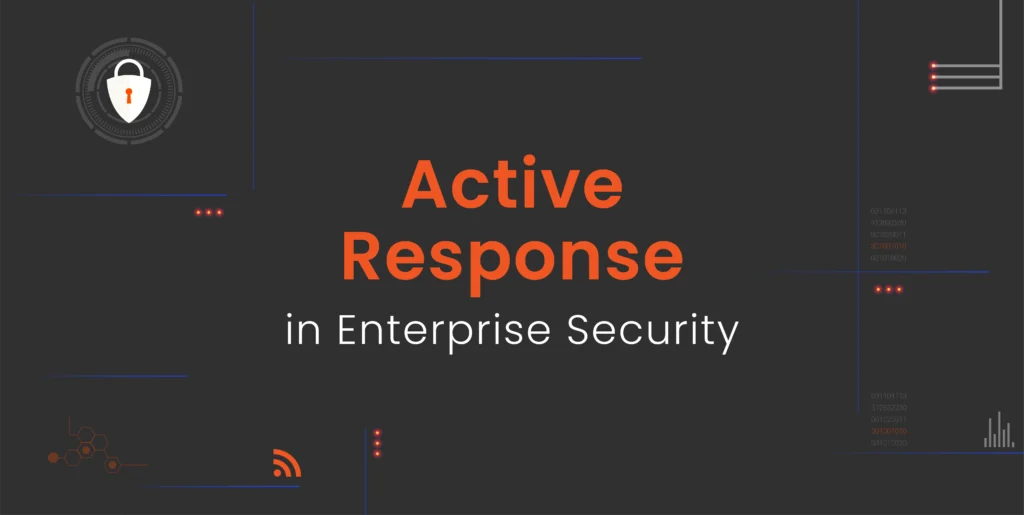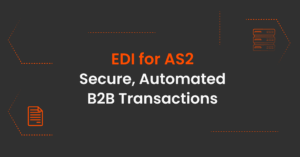In today’s rapidly evolving digital landscape, cybersecurity threats are more sophisticated and frequent than ever before. To combat these challenges, businesses must adopt proactive security measures, and this is where active response in enterprise security comes into play. Active Response refers to the immediate, automated actions taken by security systems to detect, contain, and neutralize cyber threats in real-time.
Unlike passive security measures, which focus on detecting and alerting threats without immediate intervention, Active Response enables systems to act instantly, minimizing the damage caused by an attack.
The difference between Active and Passive Response lies primarily in the approach to threat management.
Passive security measures, such as firewalls and intrusion detection systems, are designed to identify threats and alert administrators but leave the resolution to human intervention. In contrast, Active Response systems take matters into their own hands, automatically blocking malicious activity, isolating compromised devices, and even counteracting attacks without waiting for human input. This real-time action is crucial, as delays in response can allow cybercriminals to escalate their attacks, resulting in greater damage and more complex recovery processes.
Why is Active Response crucial for enterprises?
For enterprises, the importance of active response cannot be overstated. A cyber attack can lead to significant financial loss, reputational damage, and operational disruptions. Active Response minimizes these risks by swiftly neutralizing threats and preventing them from spreading across the network.
In a world where downtime or data breaches can have severe consequences, an agile cybersecurity strategy that includes Active Response ensures business continuity and protects sensitive data. For businesses to stay resilient and competitive, implementing an Active Response framework is no longer optional, it’s a necessity.
The Cost of Not Applying Active Response in Enterprises
In the fast-paced world of cybersecurity, the cost of failing to implement Active Response can be astronomical. Large companies, particularly those in highly regulated industries, cannot afford to wait for an attack to unfold before taking action. Without Active Response, organizations risk prolonged downtime, loss of critical data, and damage to their reputation. As cyber threats grow increasingly sophisticated, relying on traditional passive measures alone puts companies at a serious disadvantage.
One real-life example of the severe impact of not having Active Response in place is the 2017 WannaCry ransomware attack. This attack spread across the globe, affecting more than 200,000 computers in over 150 countries, including large organizations like the UK’s National Health Service (NHS). The ransomware exploited a vulnerability in Windows operating systems, encrypting files and demanding payment for their release. However, many companies and institutions failed to implement timely patches and lacked systems that could have actively detected and blocked the attack in real-time.
The NHS, for instance, was severely impacted, with over 70,000 medical devices and computers affected. Hospitals had to cancel surgeries, appointments, and divert emergency services, causing significant operational disruption. In total, the WannaCry attack is estimated to have caused over $4 billion in damages globally.
This incident underscores the importance of Active Response in preventing and mitigating the impact of such threats. If the NHS had deployed automated systems capable of real-time threat detection and neutralization, the spread of WannaCry could have been contained more quickly, limiting damage and avoiding the widespread disruption to services.
The WannaCry attack serves as a stark reminder of the high cost of complacency in cybersecurity. Without Active Response, businesses expose themselves to risks that can cripple operations, cause financial damage, and harm their reputation in the market. Read more about WannaCry’s impact here.
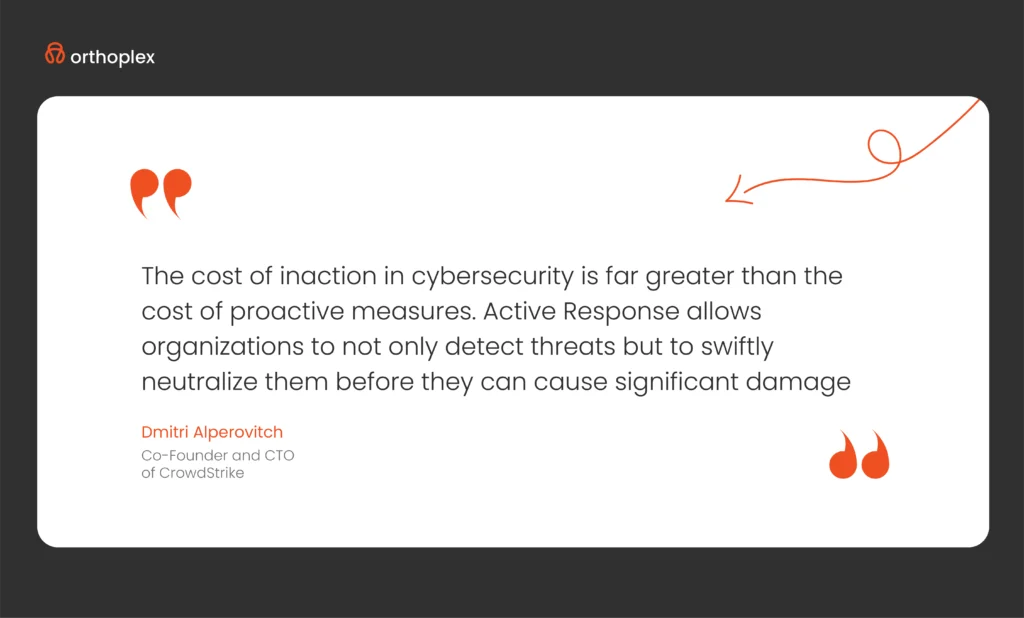
Key Components of Active Response in Enterprise Security
1. Real-Time Monitoring and Detection
Real-time monitoring and detection are foundational to Active Response in cybersecurity. Continuous monitoring allows organizations to track network traffic and system activities, identifying potential threats as they emerge. Tools like SIEM (Splunk, IBM QRadar) and EDR (CrowdStrike, SentinelOne) offer advanced threat detection capabilities, allowing security teams to spot anomalies and potential intrusions swiftly.
These systems aggregate and analyze data across all endpoints and networks, providing a real-time view of the organization’s security posture. This enables rapid identification of threats, empowering teams to respond before a minor issue escalates into a significant breach.
2. Automated Detection Systems
Automation plays a critical role in enhancing the efficiency of cybersecurity responses. By integrating AI and machine learning with detection systems, organizations can significantly improve response times and reduce human error. Automated detection systems can analyze vast amounts of data in real-time, quickly identifying suspicious activities without the need for manual intervention.
AI algorithms are capable of recognizing patterns and anomalies, allowing the system to predict potential threats before they fully materialize. This automation not only accelerates threat identification but also ensures that responses are consistent and more accurate, reducing the risk of oversight or delay.
3. Endpoint Containment and Isolation
Endpoint containment and isolation are key components of Active Response to prevent the spread of threats across an organization’s network. When a device is compromised, it is critical to immediately identify and isolate it from the rest of the network to stop further infection or damage.
EDR solutions like CrowdStrike and SentinelOne offer tools that automatically detect and contain threats at the endpoint level. These tools can isolate infected devices by severing their network connections, preventing malware from spreading and ensuring that the rest of the network remains secure. This containment helps minimize the impact of a cyberattack.
4. Incident Response Plans
A well-defined incident response plan is essential for guiding an organization through the process of handling a cybersecurity breach. An effective incident response plan outlines roles, responsibilities, and procedures to follow during an attack.
Key elements include clear communication channels, escalation procedures, and predefined response actions, ensuring a coordinated effort. These plans also prioritize the identification and containment of threats, followed by root cause analysis, recovery, and post-incident review.
A robust incident response plan helps organizations act swiftly and effectively, minimizing the time it takes to mitigate a threat and restoring business operations with minimal disruption.
5. Role of Machine Learning and AI
Machine learning and AI play a crucial role in enhancing the capabilities of Active Response systems. Machine learning algorithms can analyze vast datasets to detect unusual patterns and predict potential threats.
These systems learn from historical data, continuously improving their ability to spot emerging threats. By using AI-powered automation, security teams can achieve faster, more accurate responses to cyberattacks.
Machine learning helps predict attack vectors and identify zero-day vulnerabilities that may not yet have a known signature. With AI integrated into detection systems, organizations can respond more effectively to advanced and evolving cyber threats, reducing the time to action.
Types of Active Responses
1. Real-Time Containment
Real-time containment involves immediate actions to halt an ongoing attack and prevent further spread. Once a threat is detected, the affected system or network segment is isolated to limit damage. Network segmentation ensures that compromised devices are removed from critical environments, minimizing potential harm.
Techniques like disconnecting from the internet, disabling compromised accounts, or blocking network communication prevent the attacker from escalating their access or infecting other systems. By implementing real-time containment, organizations can contain the attack’s scope while preventing data loss, ensuring the continuity of unaffected operations.
2. Quarantine Procedures
Quarantine procedures play a crucial role in active response by isolating infected devices or systems to prevent the spread of malware. Once a device is detected as compromised, it is placed in a secure, isolated environment where it cannot communicate with the rest of the network.
This reduces the risk of the infection propagating to other devices or systems. Quarantining minimizes business disruption and gives IT teams time to investigate the root cause of the breach, perform necessary diagnostics, and begin remediation efforts without risking additional damage or data loss.
3. Malware Removal and Artifact Eradication
Malware removal and artifact eradication are vital in ensuring that a cyberattack does not leave lingering threats. After an attack, it is essential to thoroughly cleanse systems of all malicious software and compromised components. Tools like antivirus software, endpoint detection and response (EDR) solutions, and manual scanning help identify and remove malware, as well as delete any artifacts such as backdoors or malicious scripts that might remain.
Additionally, compromised credentials and access points are eliminated to prevent attackers from regaining control. This step ensures that no traces of the threat remain in the environment.
4. Vulnerability Patching
Vulnerability patching is an essential active response to prevent attackers from exploiting known weaknesses in software or systems. Once a threat has been detected, addressing any exploited vulnerabilities is critical in stopping future breaches. This process involves applying the latest security patches or updates to systems, applications, and devices that were targeted during the attack.
Timely vulnerability patching not only closes entry points but also strengthens the organization’s defenses, making it harder for attackers to infiltrate again. It is a proactive defense measure that helps mitigate risk and fortifies security across the enterprise.
Now that we’ve discussed the immediate actions taken during an attack, it’s crucial to shift focus to the post-incident phase. Active Response in Enterprise Security during this stage is vital for understanding the impact of the attack, learning from it, and strengthening future defenses.
Post-Incident Management and Continuous Improvement
1. Forensic Analysis and Root Cause Investigation
Forensic analysis is a critical step in understanding how an attack unfolded and identifying its origin. By examining logs, network traffic, and system behavior, security teams can trace the attack’s path and pinpoint vulnerabilities that were exploited.
Tools like FTK or X1 Social Discovery are essential for gathering evidence that can uncover how the breach occurred. Root cause investigations help businesses understand if the attack was due to human error, misconfigured systems, or overlooked vulnerabilities, and can provide insights for improving future cybersecurity strategies.
2. Post-Incident Review Processes
Post-incident review processes are essential for businesses to evaluate their response and identify areas for improvement. After addressing the immediate threat, organizations should conduct a thorough debrief, analyzing the timeline of events, the efficiency of the response, and the effectiveness of security controls.
This review allows security teams to identify gaps in their preparedness and refine incident response protocols. Learning from each incident strengthens defenses, making organizations more resilient to future attacks and ensuring that lessons learned translate into better strategies moving forward.
3. Comprehensive Post-Incident Reporting
Clear and actionable post-incident reports are vital for businesses after a cyberattack. These reports serve multiple purposes: they provide documentation for compliance, inform stakeholders of the impact, and guide operational improvements. A well-crafted post-incident report details the scope of the breach, the actions taken, and the consequences of the attack, offering insights for strengthening security posture.
These reports also help businesses fulfill regulatory requirements, address customer concerns, and improve internal processes to prevent similar incidents in the future.
4. Customized Playbook Updates
After an incident, updating the organization’s incident response playbooks is a crucial step. Playbooks outline step-by-step procedures for responding to different attack scenarios, and post-incident updates ensure they remain relevant. Businesses can use the insights gained from the attack to refine their strategies, add new response tactics, and address previously unnoticed vulnerabilities.
Customizing these playbooks ensures that the team is better prepared for future threats, improving response times and effectiveness. Every attack offers an opportunity to enhance these protocols and create more robust defense mechanisms.
5. Stakeholder Briefings and Transparency
Stakeholder briefings and transparency are key components of managing a post-incident scenario. Ensuring that all relevant parties like employees, customers, shareholders, and regulatory bodies, are informed fosters trust and keeps them aligned with the company’s recovery efforts.
Regular briefings during and after an incident help stakeholders understand the steps being taken to address the issue, and how the company plans to prevent similar occurrences.
Transparency is crucial in maintaining confidence and ensuring that all parties are aware of potential risks, regulatory implications, and the company’s commitment to protecting data and assets.
Integration with Existing Security Frameworks
1. Seamless Integration with Internal Security Teams
Active Response is designed to complement, not replace, existing IT and security teams. By adding a layer of agility and proactive defense, Active Response enhances the capabilities of internal teams without causing disruption.
For example, while internal teams may focus on routine security maintenance, Active Response can provide real-time detection and immediate containment measures, allowing security professionals to respond to threats more efficiently.
This collaboration allows organizations to maintain strong internal controls while integrating dynamic, real-time defense mechanisms that can quickly neutralize emerging threats, thus strengthening their overall security posture.
2. Integration of Threat Intelligence
Threat Intelligence Platforms (TIPs) play a crucial role in enhancing active response efforts by providing real-time threat feeds. Integrating these platforms into the active response system ensures that security teams have access to timely, actionable information on emerging threats.
This integration allows for quicker detection, more accurate predictions, and faster responses to attacks. By utilizing platforms like ThreatConnect or Anomali, companies can leverage external threat data, such as indicators of compromise (IoCs), attack patterns, and threat actor tactics, to inform their security decisions and prevent potential breaches before they occur.
3. Industry-Specific Defense Strategies
Cybersecurity needs vary significantly between industries such as finance, healthcare, retail, and government, and Active Response frameworks can be tailored to each sector.
For example, in finance, real-time transaction monitoring and anti-fraud measures are critical, while healthcare requires protection of patient data with stringent privacy regulations like HIPAA. Retail businesses must focus on securing customer payment information, and government entities often require enhanced threat detection due to high-value national security data.
By customizing Active Response strategies to the unique challenges and compliance requirements of each industry, organizations can enhance their defenses, improve risk management, and ensure they meet sector-specific cybersecurity standards.
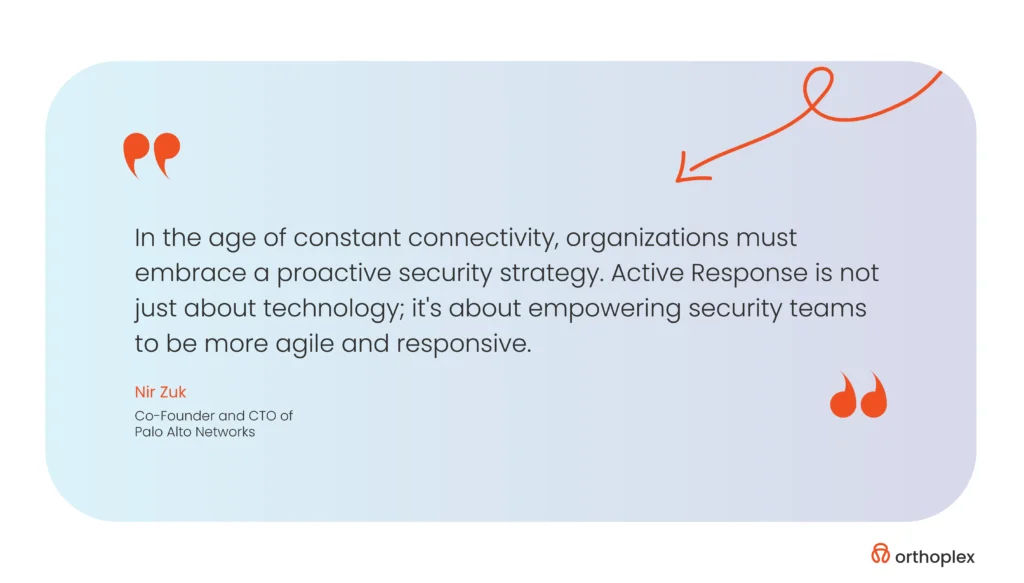
Top 5 Active Response Software for Enterprises in 2025
As cyber threats continue to evolve, selecting the right active response software is crucial to ensure your enterprise is well-equipped to respond to security incidents in real time. At Orthoplex Solutions, we’ve analyzed and compiled a list of the top active response software solutions for 2025 to help organizations make informed decisions. Here’s an overview of the best players:
1. Wazuh
Wazuh is an open-source security information and event management (SIEM) platform with powerful threat detection, compliance management, and log analysis capabilities.
Pros
- Cost-effective and open-source, making it an attractive option for enterprises with tight budgets.
- Highly customizable and scalable, offering flexibility for businesses of various sizes.
- Real-time threat detection and in-depth log analysis for swift incident response.
Cons
- Requires significant technical expertise to set up and manage effectively.
- Lacks some advanced automation features found in more specialized tools.
Best for
Enterprises seeking a budget-friendly, customizable solution that can grow with their business.
2. Microsoft Defender for Endpoint
Microsoft Defender for Endpoint is a comprehensive endpoint protection platform that provides enterprise-grade security integrated into the Microsoft ecosystem.
Pros
- Seamless integration with the Microsoft 365 suite and Windows-based environments.
- Advanced AI-driven threat detection and response capabilities.
- Strong threat intelligence and integration with other Microsoft security services.
Cons
- Expensive, especially for smaller businesses or those without an existing Microsoft ecosystem.
- High reliance on Microsoft products, which may limit flexibility for businesses with diverse IT infrastructures.
Best for
Enterprises already leveraging Microsoft tools and services, looking for end-to-end protection.
3. CrowdStrike Falcon
CrowdStrike Falcon is a cloud-native endpoint protection platform that utilizes AI and machine learning for proactive threat detection and mitigation.
Pros
- Exceptional performance and speed in detecting and responding to threats in real time.
- AI-driven threat detection that adapts to emerging attack tactics.
- Lightweight agent that is easy to deploy and manage.
Cons
- High licensing costs, particularly for larger organizations.
- Limited offline capabilities, which may be a concern for environments with poor connectivity.
Best for
Large organizations that require cutting-edge endpoint protection and rapid threat response.
4. Splunk
Splunk is a powerful SIEM and log management platform designed to provide deep data insights and real-time active response capabilities.
Pros
- Robust analytics and visualization tools for in-depth threat analysis.
- Highly scalable, making it suitable for organizations of all sizes.
- Extensive integration options with a wide range of third-party tools.
Cons
- Steep learning curve for new users and security teams.
- Expensive licensing fees, particularly for enterprises with large data volumes.
Enterprises that need comprehensive data analytics alongside active response capabilities to stay ahead of evolving threats.
5. IBM QRadar
IBM QRadar is an advanced SIEM solution known for its robust threat intelligence, comprehensive active response, and scalability.
Pros
- Advanced threat intelligence and analytics that provide actionable insights.
- Scalable architecture designed for large organizations with complex security requirements.
- User-friendly interface that simplifies security management.
Cons
- High implementation and maintenance costs, especially for smaller businesses.
- Requires specialized expertise to maximize the value of the solution.
Best for
Large enterprises with complex, high-stakes security needs and the resources to manage sophisticated tools.
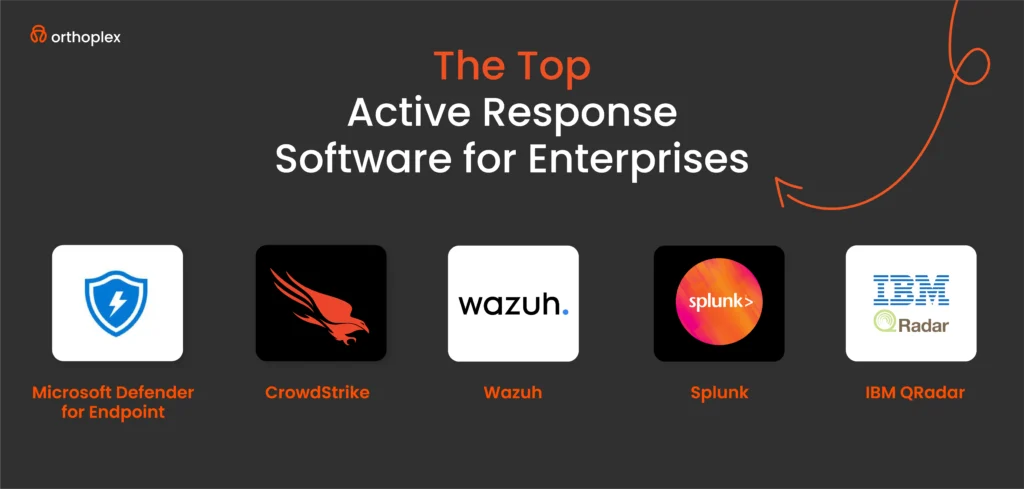
How to Choose the Right Active Response Solution for Your Enterprise?
Selecting the right active response solution depends on your organization’s unique needs. Consider these factors:
- Assess Your Security Gaps: Evaluate the specific threats your business faces and choose a solution that addresses these vulnerabilities.
- Evaluate Budget Constraints: Consider the total cost of ownership, including licensing, maintenance, and training.
- Consider Integration: Choose a solution that integrates seamlessly with your existing security infrastructure to avoid disruption.
- Prioritize Scalability: Ensure the solution can grow with your business as you expand.
- Trial and Testing: Take advantage of free trials or demos to assess the tool’s performance and suitability for your business.
Now that you have a clear understanding of the top active response software solutions available, it’s essential to consider the operational aspects required to effectively implement these technologies within your enterprise systems.
Ensuring a seamless integration and efficient functioning of these solutions involves a well-structured approach and collaboration with key teams and external partners. Let’s explore what it takes to operationalize these advanced tools and ensure your organization is fully equipped to tackle cyber threats head-on.
Operational Aspects of Active Response
1. Formation and Role of Cyber Incident Response Teams (CIRTs)
Cyber Incident Response Teams (CIRTs) are specialized groups within an organization, responsible for responding to and mitigating cyber threats. These teams are typically composed of experts from various domains, including IT, legal, and communications. CIRTs play a crucial role in managing incidents by quickly identifying, containing, and resolving security breaches.
They work closely with internal teams, ensuring a coordinated approach to minimize the impact of cyber threats on operations and data. Implementing an effective CIRT is key to enhancing your organization’s active response capabilities.
2. Collaboration with Third-Party Vendors
Third-party vendors provide essential tools, expertise, and additional resources to strengthen an organization’s active response efforts. Collaboration with these vendors helps integrate specialized software solutions, enhance threat intelligence, and improve overall response time.
Security vendors offer support in areas like incident detection, containment, and remediation. By working with trusted external partners, organizations can access the latest cybersecurity technologies and best practices, allowing them to stay ahead of evolving threats and maintain robust protection across their enterprise.
Discover How Orthoplex Solutions Can Help You Implement Active Response
At Orthoplex Solutions, we specialize in seamless integration of advanced active response solutions tailored to your enterprise’s specific needs. Our team of experts will guide you through every step ensuring your systems are fortified against potential cyber threats. Reach out today to discover how we can help you strengthen your cybersecurity posture.
Common Challenges in Active Response
Implementing Active Response strategies can be challenging for businesses, with several key obstacles to overcome. One of the primary issues is resource constraints, many organizations struggle to allocate the necessary budget, personnel, and technology to establish an effective active response system.
Additionally, coordination between internal teams and external partners can become cumbersome, especially during high-pressure incidents. The ever-evolving nature of cyberattacks further complicates the situation, as cybercriminals continuously adapt their tactics, making it difficult for businesses to stay ahead and maintain proactive defenses.
Solutions to Enhance Active Response in Enterprise Security Effectiveness
To address these challenges, businesses can leverage advanced technologies, invest in comprehensive training programs, and foster a culture of collaboration. The use of automated tools and machine learning can significantly enhance response times and accuracy. Regular drills and scenario-based exercises are also essential for building preparedness across teams.
Furthermore, continuous improvement is key, learning from past incidents, refining strategies, and updating response plans ensures that organizations stay agile and can effectively tackle emerging threats.
Combining these strategies allows businesses to maximize the effectiveness of their active response efforts.
As organizations continue to evolve their cybersecurity strategies, implementing Active Response solutions not only strengthens defenses but also delivers tangible outcomes. The benefits of Active Response are clear, providing both immediate and long-term advantages for businesses looking to safeguard their operations.
Let’s explore the key impacts and outcomes that Active Response can bring to your enterprise.
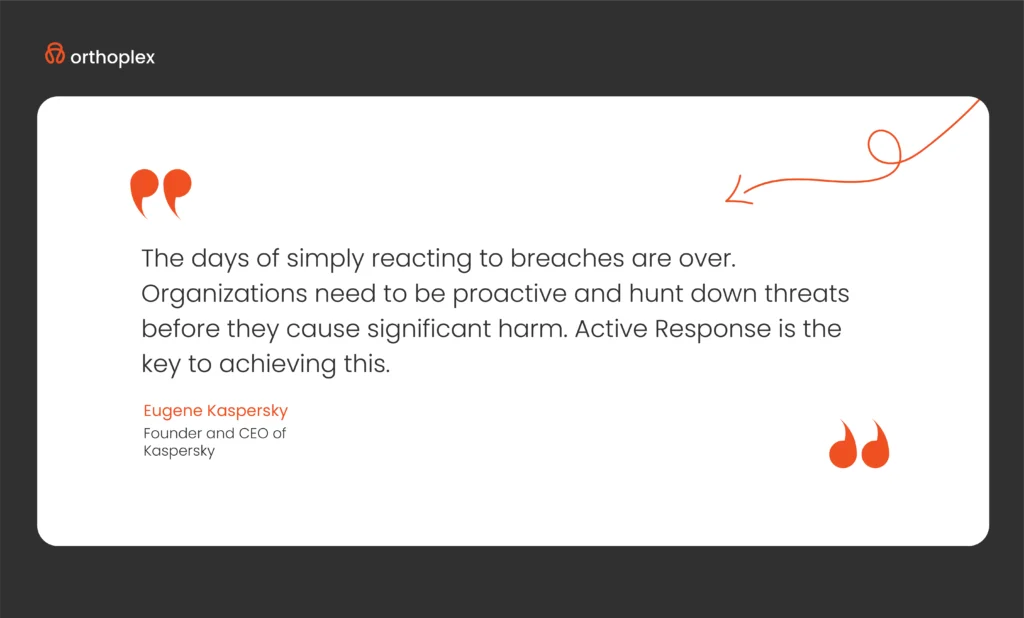
Impact and Outcomes of Implementing Active Response in Enterprise Security
Minimized Impact and Uninterrupted Operations
Active Response plays a crucial role in ensuring that business operations continue with minimal disruption during a cyberattack. By leveraging real-time threat detection and rapid containment measures, businesses can quickly neutralize threats before they escalate, ensuring continuity.
This proactive approach also safeguards the company’s reputation and protects critical data, preserving both customer trust and regulatory compliance. In a world where downtime can cost businesses millions, active response strategies are vital for maintaining operational integrity while minimizing financial and reputational damage.
Resilient Recovery Solutions
Implementing Active Response enhances an organization’s ability to recover quickly and fully from cyber incidents. Recovery solutions such as cloud-native platforms and network forensics tools allow businesses to restore operations efficiently, ensuring minimal data loss and faster recovery times.
These technologies also play a role in strengthening defenses, preventing future breaches. By continually improving incident response capabilities and refining security measures, businesses can not only bounce back from an attack but also fortify their defenses against future threats, ensuring long-term cybersecurity resilience.
Reduced Time-to-Detection for Emerging Threats
Active Response systems significantly reduce the time-to-detection for emerging threats by utilizing predictive defense capabilities and advanced behavioral analysis. These tools allow security teams to identify unusual activities and potential attack patterns early, even before they fully materialize.
Adaptive defenses further enhance this process by continuously learning from new data and rapidly adjusting to block novel attack vectors. By reducing the time to detect new threats, businesses can minimize the window of vulnerability, preventing attacks before they can cause significant harm.
Conclusion
In conclusion, Active Response is a crucial element for modern cybersecurity strategies, particularly as cyber threats continue to evolve in sophistication and frequency. The ability to detect, respond to, and contain threats in real-time is no longer a luxury but a necessity for businesses of all sizes. Through proactive detection, immediate containment, and continuous monitoring, Active Response minimizes the risk of significant damage from cyberattacks, ensuring business continuity and protecting critical data.
The integration of advanced tools, such as AI-driven threat detection and machine learning, strengthens the effectiveness of Active Response solutions, enabling faster, more accurate identification of threats. Furthermore, the role of cybersecurity incident response teams (CIRTs), combined with a robust post-incident management process, helps organizations learn from past attacks and refine their defense strategies for future incidents. By continuously updating response plans and improving systems, enterprises can stay ahead of emerging threats.
However, implementing these advanced Active Response solutions can present challenges, such as resource constraints and coordination issues. Despite these obstacles, businesses can overcome them through careful planning, the adoption of the right technologies, and by empowering collaboration between internal teams and third-party vendors.
Continuous improvement, training, and conducting drills are essential in enhancing the effectiveness of Active Response measures.
Ultimately, the benefits of Active Response, like minimizing operational impact, ensuring rapid recovery, and reducing detection times for emerging threats, make it an indispensable part of any cybersecurity strategy.
By investing in the right tools and solutions, businesses can enhance their cybersecurity posture, ensuring they are well-prepared to face an ever-changing threat landscape.
To discover how Orthoplex Solutions can help you implement Active Response and elevate your cybersecurity defenses, contact us today.

